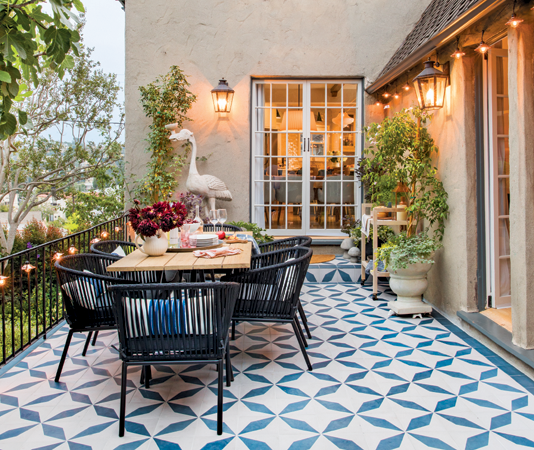
Chapter 10
The Outdoor Spaces
IT’S TIME TO GET OUTSIDE FOR SOME FUN IN THE SUN.

FOR ALL OF its glorious wonders, the great outdoors doesn’t offer much in the way of storage. And, if you even think about shoehorning another thing into the garage, you won’t have room for the car. When it comes to organizing all the things that make the outdoors fun, you want your stuff (sports equipment, garden tools, etc.) to be accessible when you need it and easy to store when you don’t. After all, tending to your garden or playing a round of badminton with the family should relieve stress, not add to it.
Thankfully, everyone can chip in to make sure soccer balls make it back into their designated bags and tools are kept in their proper spot for the next time a bike needs repairing. Plus, it’s much easier to turn cleanup into a fun game (1 point for every baseball that makes it back into the bag!) when you’re working with outdoor toys. And, in this kind of competition, the result is a put-together space that the whole family can use. In other words, everyone wins.
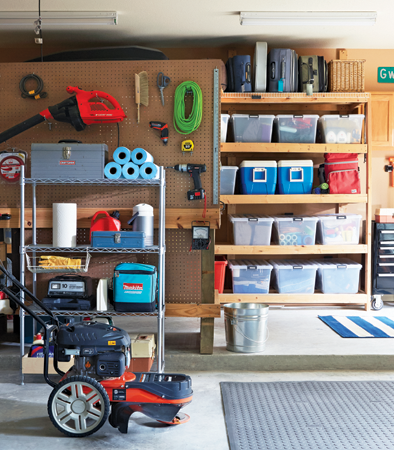
Making yourself a designated gardening center will give you perennial joy—and not just when spring hits. Keep all your essentials sorted by item, and hang tools together, too.
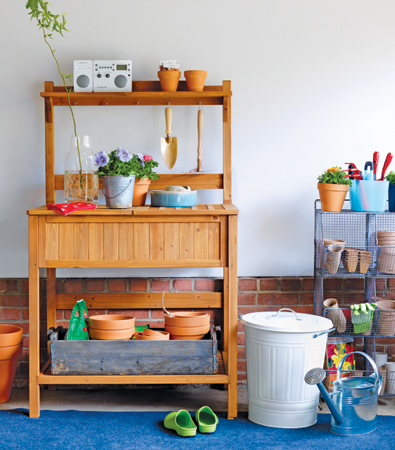
A tidy garage is a thing of joy, especially before a big home-improvement project. Clearly labeled see-through bins keep everything (including your sanity) together.
When it’S NICE OUTSIDE, THE LAST THING YOU WANT TO DO IS TIDY UP BEFORE YOUR FUN IN THE SUN. GET TO THE GOOD TIMES FASTER WITH A SYSTEM THAT’LL KEEP EVERYTHING IN ITS PLACE AND REQUIRE LITTLE TO NO UPKEEP ON YOUR DAYS OFF, WHICH YOU SHOULD BE SPENDING IN THE SUNSHINE.
Hide the Hose

Never let them see—or trip over—your garden hose. Keep it handy by hiding it in a ceramic hose pot, which looks like a pretty vase in your yard. Or, if you’re just looking for a simple way to store your hose kink-free, a wall-mounted hose reel or hanger does the trick, too.
Gardening
How does your garden grow? In an organized fashion, thank you very much.
Gather Your Tools

When you make the most of wall space—like putting gardening gear on a pegboard—your stuff stays within easy reach, and the space looks a lot neater. Most hardware stores will cut pegboard to any dimensions you like, and a fresh coat of paint can give it a fun pop of color. For a smaller way to hang, a wire cooling rack (like what you’d rest cookies on when you remove them from the oven) can also hold odd-shaped items with hooks. And, it’s not just a gem for gardening. Keeping items you’re always looking for, like a hammer, flashlight, or tape measure, on a pegboard puts them in the spotlight.
Move Work Gloves to a Wine Rack (Yes, a Wine Rack)

Hang the rack on the pegboard. It’s just the right size to hold gloves, flashlights, and other odds and ends currently strewn all over your workbench.
Be on the Move
A rolling tool organizer, whether you use it for gardening tools or car doodads, has plenty of slots for tall tools, as well as pockets for gloves and snippers. It moves from the garage to the yard, eliminating back-and-forth trips for forgotten gear.
Pot Your Potting Soil
Bags of potting soil and fertilizer can tip over easily (and they’re not much to look at anyway). Instead, pour the soil into rarely used kitchen pots with lids or cheap enamel vessels. Or, for bigger bags, go with an Oscar-the-Grouch-style garbage can.
Put a Lid on Birdseed
A galvanized metal bucket with a locking lid keeps squirrels or other critters from getting into birdseed.
Rethink Your Toolbox
Sure, a traditional tin toolbox can carry, well, tools, but it’s also a great place to store small outdoor necessities like citronella candles, bug spray, and dog leashes.
Deck & Pool
MAKE A SPLASH WITH THESE IDEAS.
Entertain With Unbreakables

No glass allowed outside; melamine dinnerware is a much better option for outdoor dining. It comes in fun patterns, is unbreakable, and can go in the dishwasher. Store it in the house when it’s outdoor-entertaining season and in a waterproof plastic bin in the fall.
Prepare Grills and Propane Tanks for Winter
Before you wheel your gas grill to the garage for its cold-weather hibernation, disconnect the propane tank, which must stay outside year-round. (Propane is impervious to heat or cold, and it’s illegal to put a propane tank larger than one pound in an enclosed area because it could leak and cause an explosion. Instead, keep it at least five feet from your house so that you’re adhering to fire code.) After you detach it, check it for leaks by closing the valve, then sponging the valve and nozzle (where it attaches to the grill) with soapy water. If the liquid foams or bubbles, check that the valve connection is tight. If it is, you probably have a leak, and you’ll need to call your dealer for disposal instructions.
Protect Yard Furniture

When summer ends, make sure the cushions are completely dry before placing them in large plastic boxes. (Poking holes in the boxes first will help prevent mildew.) Store lighter furniture, like plastic, wood, and wicker, indoors, preferably in the attic, because basements and garages can get damp. It’s ok to leave heavier furniture, like wrought iron, outside, but protect it with a tarp or furniture cover with a drawstring cord. And don’t forget to remove glass tabletops and store them in a safe corner where they won’t be knocked over.
The Garage
MAKE ROOM FOR FUN TIMES (AND, YOU KNOW, THE CAR).

Look Up
Technically, the ceiling is the fifth wall to your garage, and thankfully, most have plenty of vertical space for hanging bicycles, kayaks, and other large outdoor gear. Plus, hanging bikes against the far wall of the garage will help as a visual guide for pulling the car into the garage (and not tapping the back wall with your bumper). If you don’t have much vertical space, try a wall-mounted track organizer, which has hooks and shelves, to hold things like a bicycle, a ladder, and garden supplies.
Stow Sports Equipment

Keep your family’s gear in netted bags that can hang from hooks in the garage, or slip them into a hall closet. Stash tennis balls and baseballs in one, and a basketball in another. For bats, racquets, and golf clubs, repurpose an umbrella stand.
Ask The Organizer
Q: MY PACK-RAT HUSBAND USES OUR GARAGE AS A CATCHALL. HOW DO I DIPLOMATICALLY NEATEN IT UP?
A: In a “stuff discordant” relationship like this, the first step is to agree on a problem you can solve together. Bring it up when you’re feeling connected, like after a night out. Say, “Hey, can we talk about the garage? It’s getting tough to park in there, right?” When he agrees, respond, “How about we take a crack at it next weekend?” Set aside a morning or afternoon, and with a heavy-duty garbage bag and a box for recycling in hand, hunt for “low-hanging fruit”—objects that can clearly go, like a broken CD player. Seeing progress right away is motivating.
Next, lay down an old sheet and match up all the remaining items: sports gear with sports gear, lawn-care supplies with lawn-care supplies. Sorting this way gives you a clear visual of quantities, making it simpler to pull out duplicates. Narrowing down the rest is trickier. Have him pick up each item and ask, “Do I really need this? Am I keeping it for deeply sentimental reasons or just because it was pricey or a bargain?” Collect castoffs in cardboard boxes for a thrift store. The rest of the stuff will stay neater if you sort and store by category (tools, sports equipment, mementos, etc.). To get as much as possible off the floor, line the garage’s perimeter with rolling metro shelves, and add clear plastic tubs labeled with the contents.
—ANDREW MELLEN, ORGANIZER
Pro Tip
“I love rust-proof drawer units, such as those great Bisley drawers that come in a ton of colors. I use them for my gardening tools because they’re so durable. It’s important that, just like in your house, you have a space in the garage for these things so that they’re not just heaped. The drawers can also be repurposed in so many ways, like for storing kids’ Legos, too!”
—ELLEN MADERE, ORGANIZER
Organize This
MAKE THE WORKBENCH WHERE YOU BUILD PROJECTS, WELL, WORK FOR YOU.

PLACE PEGBOARD
A pegboard along the wall of your workbench means everything you need will always be visible and within reach. Outline items with a paint pen while they’re hanging. When they’re gone, you’ll have a fun visual reminder of where they go.
TIE UP TWINE
Store twine and electrical and duct tape rolls (wire spools, too) on a ribbon or rope that you can easily untie if you need to remove one. Then hang it on the pegboard.
MAKE A JUNK BOX
A tiny shelving unit is a great place to store small parts and extra nails and screws. The drawers keep it all organized.
KEEP A CLEAN SURFACE
It’s hard to do any work without a clutter-free surface area. Use empty tin cans or cups to hold scissors and pencils that could otherwise muck up your work area.

Car Decluttering 101
DON’T TAKE YOUR MESS EVERYWHERE YOU GO. HERE’S HOW TO CLEAN UP YOUR WHEELS.
Switch Gears
If you regularly leave coloring books and unfinished snack packs on the backseat for later, car clutter inevitably piles up. So put a waste can in the garage to make trash disposal automatic. Also, set a new family rule: Anything you bring into the car needs to come out when you get home. Of course, there are basic essentials that do need to be in there, like a flashlight, an umbrella, and a first-aid kit. But storing those in an over-the-seat organizer is risky—it’s tempting to treat it like a catchall. Instead, opt for an out-of-the-way trunk organizer.
Move Your Castoffs to the Car
When you know there’s a box or a basket in the trunk waiting for giveaways, it becomes second nature to regularly off-load old or unused items so they’re not hogging space in the closets. A full container is a cue to officially let go: Bring the box to a charitable organization (like The Salvation Army), or mail it through givebackbox.com, which offers free shipping labels to send items to a local Goodwill.
Corral Loose Coupons and Store Credits
You’re much more likely to cash in coupons and credits if you keep them together in one spot that’s easy to access when you’re shopping—and that spot is the car. Use a clear zippered envelope tucked inside the overhead visor.
Make a Plan
For overall upkeep, plan on pulling into a gas station or car wash to vacuum the car once a month. Having that on the calendar will make you more apt to keep up the decluttering in the off weeks.
The Tools

METRO SHELVING

BIG PLASTIC BINS
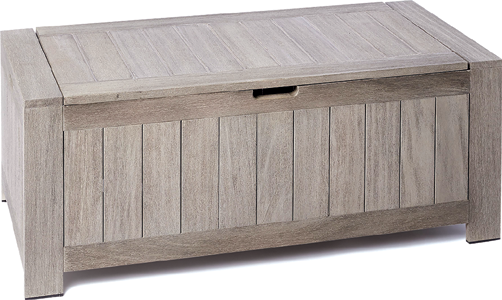
OUTDOOR STORAGE

STEP STOOL
If you’re going to use every square inch of your garage space, that means building up.

BISLEY TOOL CABINET
ORGANIZING ESSENTIAL
A Bisley tool cabinet can hold all types of items, from tools to toys, and it keeps everything tucked away and out of sight.
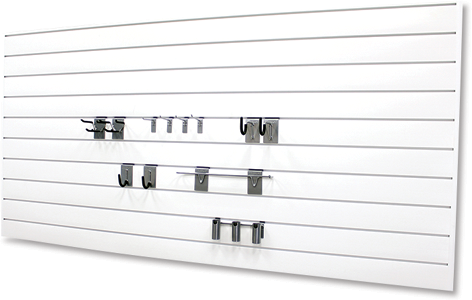
WALL BOARD AND HOOKS

HOSE ORGANIZER

CAR TRUNK ORGANIZER

MELAMINE PLATES
They’re a step up from paper or plastic, are practically unbreakable, and can go in the dishwasher when the party’s over.
Small-Space Solutions
TRUTH: MOST GARAGES AND PATIOS AREN’T HUGE TO BEGIN WITH. HERE’S HOW TO MAKE THE BEST OF THE SMALL SPACE YOU’VE GOT.

Do Double Door Duty
No room for a proper tool bench and the storage that comes with it? Hang a fabric shoe organizer on the back of a door and fill it with gardening tools, spray paint cans, seedlings, and any other small items you’ll want to keep handy.
Hang Chairs
Folding beach or lawn chairs don’t have to lean against the garage wall, where they take up space and can fall over easily. Instead, hang them along the wall with nails.
Use Corners
Add corner shelving with plywood (or you can buy it, too) to store bottles and tools without taking up room where your car should be.
Make a Recycling-Bin Rack
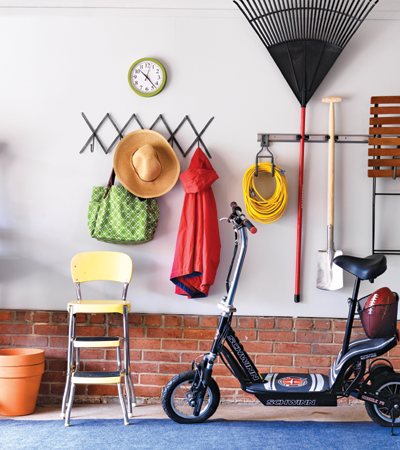
On the floor, recycling bins take up too much space. Instead, prop one up on the wall between two 2x4s screwed in horizontally on the wall. Now place a 1x4 on top of the upper 2x4, and slide it down a few inches to hold the bin in place. Screw in the 1x4. Voila.
Think Outside the Garage
If you only have space for your cars inside the garage, consider an outdoor locker system that can fit your gear, withstand the elements, and has a lock for safekeeping.
The Real Simple Method Checklist
IF YOU HAVE . . .
15 Minutes
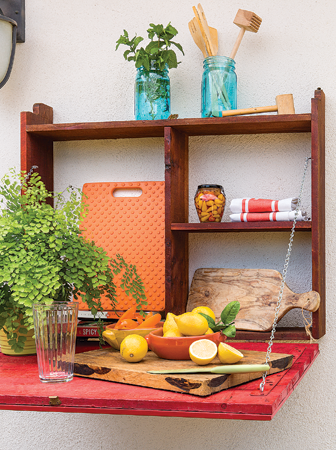
◻ TOSS THESE FEW THINGS. Quickly gather old newspapers, magazines, catalogs, and remnants of old DIY projects. To the trash they go.
1 Hour
◻ ASSIGN CATEGORIES. In the garage, give locations to these items: sports equipment, power tools, and gardening tools. Then, label the areas with blue painter’s tape and permanent marker.
◻ GIFT THE GARAGE A GARBAGE BIN. Now you’ll have a designated place to throw away food wrappers, junk you find in the yard, or other stuff from those half-finished DIY projects.
A Weekend
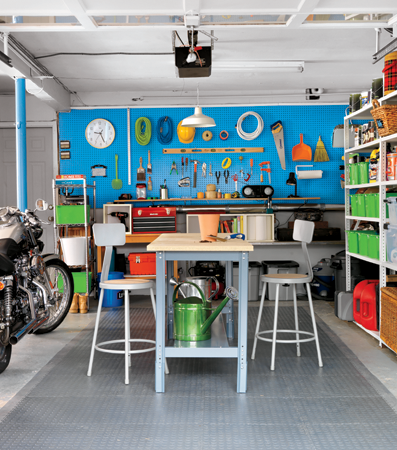
◻ INSTALL SHELVING. Metal shelving is best because it’s affordable, easy to assemble, and can withstand heat and humidity better than wood. Stack waterproof plastic containers on the shelves—clear ones mean you’ll always know what’s inside.
◻ DISPOSE OF OLD PAINT CANS. Paint usually lasts for up to 10 years unopened, and 2 to 5 years if opened and stored correctly. If you don’t need it on hand for touch-ups, or if it’s gone bad, it’s time to get rid of those bulky cans. Depending on your state, there are different laws for disposing of or recycling paint. Check to see if your state has a paint-recycling program or if there’s a waste-disposal place near your home where you can drop off the cans.
◻ RECYCLE ELECTRONICS. Chances are you have no use for that old clunky computer, printer, and fax machine from the early ’90s that have been sitting in the garage. Find a recycling program that can take them off your hands.

Ask the Organizer
Q: My kids are super-helpful when it comes to gardening, but not so much for the cleanup part. How do I get them to help out for the entire time?
A: I always hear people say, “Oh my goodness, my house is like a tornado.” But think about your kids’ classrooms—why are they always picked up? Because before they go on to another project, they’ve got to put things away. We can implement that in our lives, too. Those few minutes of cleanup have to be a tag-team effort. If you’re gardening with your kids and they say, “We’re going to go play tennis,” remind them that if they leave the tools out in the yard, they’ll rust, and then no one will get to garden. They don’t get a free pass, and neither should we.
—ELLEN MADERE, ORGANIZER
Keep It That Way
The garage and your gardening tools can feel a little “out of sight, out of mind,” but making sure all of your tools and pool accessories make it back to their homes is really more about protecting them from the elements—and making any seasonal transition a smooth one.

IF YOU DO ONE THING EVERY DAY
Always make sure there’s enough room in the garage to, ya know, park your car. When garages get cluttered, they lose their original purpose of housing your vehicles.
Avoid Stockpiles
We say this a lot, but it’s especially true when it comes to large lawn machines and bicycles. To avoid future garage pileups, commit to the “one in, one out” rule: If he brings home a new lawn mower, for example, it means you’re tossing the old one.
Rotate By Season
When it’s summer, make the camping equipment accessible on lower shelves, and move skis and poles to upper shelves. A switcheroo twice a year will save you time as you pack the car for a weekend campout with friends.
Protect Your Paint
To keep paint cans from going rusty, transfer leftover paint into clear, plastic, lidded containers with the paint color and finish written on top with a permanent marker.
Label Everything
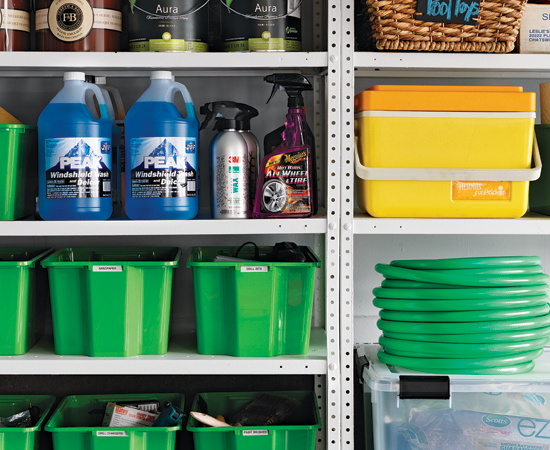
THE HACK
Keep loose balls of twine and rope contained. Place the balls in empty coffee cans, then use a pair of scissors to cut a slit in the plastic lid, and pull the end of the twine through the opening—instant dispenser!
The best way to remember where items go (especially things like holiday decorations that only come out once a year) is to label them with a label maker or a permanent marker. You’ll be happy you did so when Thanksgiving rolls around and you can’t for the life of you remember where you stashed the holiday lights.
Make It a Game
There’s no shame in rewarding family members who help stick to the system and put the soccer balls back in their bin. Or, make it a game by timing the kids to see how fast they can collectively clean the yard.
Pet Areas
FIDO’S NOT MUCH OF AN ORGANIZER. HERE’S HOW TO KEEP YOUR BEST FRIEND’S AREA TOGETHER.

Usually, pets tend to take over lots of areas of the home, but ones who roam (cats and dogs) need a main hub for eating, like in the laundry room or kitchen. And that’s usually where things go most awry, with spilling water and food. Plus, we’re not dealing with a human here who can learn how to take care of him or herself. (Sadly, a game of fetch can only go so far.) It’s your responsibility to devise a system that you can stick to for daily feedings and beyond.
Make a Pet Station
To deal with the graveyard of half-chewed bones and ratty sock monkeys under the kitchen table, stash your pet’s goodies in a tall, skinny dresser. Dedicate the top drawer to your pet’s health, with things like pills and a folder of medical records. The second drawer is for spare leashes and collars, the third for grooming supplies, and the last for bulk dog chews. Keep a dry-erase board close for important dates, like the most recent tick treatment.
Seal Up Food
As soon as you get home from the pet store, transfer any bagged dry food into a plastic container with a lid. (Plastic garbage bins work nicely.) It’s not just to keep Fido from indulging—you’ll also keep out other pests like mice.
Hang Your Supplies
Place a woven basket with a handle on a hook near the front door and include all you need for a dog walk: a leash, plastic bags, a few treats, and bandanas, if your dog is the stylish type. That way you’ll be ready to bounce out the door as quickly as your furry friend.
Q: How do I keep a stylish home when I alsohave a cat who loves to claw at things?
A: Keep a cat from clawing at your new leather sofa by distracting it with other items. And not everything has to be an ugly scratch pole. Rag rugs are not-hideous ways to save your carpet (and are machine-washable) from claws. Or a cat teepee for one is a cute way to keep a feline occupied in the corner of the living room.
PETS AND PLANTS
The following are ASPCA-approved plants that are pet safe. But to train your cat out of snacking on your greenery, make the plants unappealing by spraying the leaves once a week for a period of two months with a pet-deterrent formula like Grannick’s Bitter Apple Spray, and give pets something else to nibble.

Haworthia
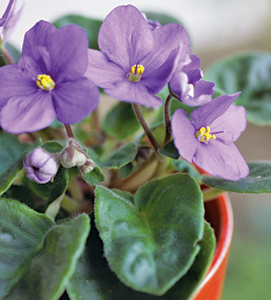
African Violet

Boston Fern

Christmas Cactus

Parlor Palm
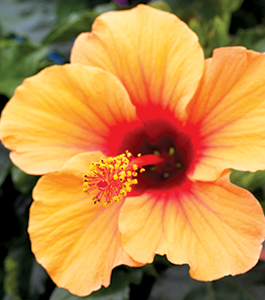
Hibiscus
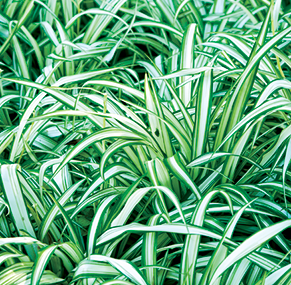
Spider Plant

Venus Flytrap

ORGANIZING ESSENTIAL
The Modkat litter box is sleek and stylish (yes, we’re talking about litter boxes here), is available in five colors, and comes with a scoop. The top-entry option means your furry friend won’t be tracking litter all over your house.
Banish Pet Hair
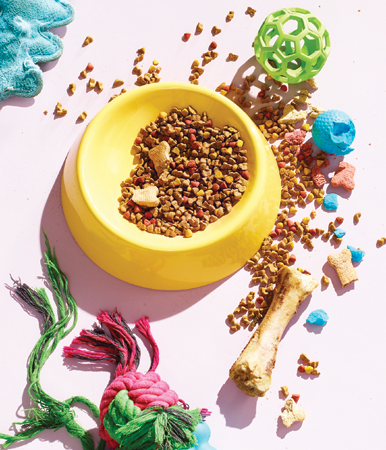
You know it’s bad when your coworkers can tell you have a pet because they can see the dog hair on your sweater. Before laundering your clothes, use a lint brush to remove as much of the hair as possible. Then wash using an animal-specific detergent that’s rich in enzymes; these cleaners break down hair and lint better than traditional laundry soaps. While the clothes are still damp, use a lint brush again to remove any last remaining hairs.
Hide a Litter Box
Keep a cat’s box in an area that’s near a trash can and won’t stink up the house, like a laundry room. (You can also store litter there.) Or a paneled private commode, available at most pet stores, can conceal an entire litter box—the hole in it lets your cat in and out.
How Often Should I…
REPLACE CAT LITTER
Every 3 to 4 weeks
CLEAN OUT THE FISH BOWL
Twice a week if it doesn’t have a filter
WASH THE DOG
Every 2 to 4 weeks for most breeds
REPLACE HAMSTER BEDDING
Weekly
REPLACE BIRD CAGE LINER
Every day
Keep It That Way
Pets make messes no matter where they go. Keep your home under control from pet dander with regular vacuuming to prevent guests from asking, “Do you have a dog?” based on smell alone. Then make sure to launder pet beds every couple of weeks or so with a gentle detergent.
How to Fix Common Pet Messes
Feathered and furry family members are cute, but they can also be pigs. These cleanup strategies should help.
1 DIRTY CAGE
A daily wipe-down with a damp paper towel is the best way to clean droppings from a hamster, a rabbit, or another small animal. That way the dropping won’t turn to dust that can be inhaled. Be sure to dry it thoroughly afterward, as a cage with damp spots can quickly grow mold (also true for crates and kennels). For a deeper cleaning (at least once a week), mix drops of dish soap in a bucket of warm water and scrub the entire surface with a nylon-bristle brush. Rinse with a handheld showerhead or a garden hose to reach the corners. Dry completely with a paper towel, or let sit in the sun for an hour.
2 RAUNCHY PET BED
Bathing your pooch at least once a month (if vet-approved) can keep doggie stench at bay. Wash the bed on the same day, so the dog doesn’t contaminate his clean sleeping spot. (A bed with a machine-washable shell and cushion is, obviously, easiest.) First vacuum the shell to remove as much fur as possible. Then toss both pieces in the washing machine and clean with laundry detergent plus four squirts of an odor eliminator.
3 STINKY LITTER BOX
Litter upkeep is cringe-worthy but crucial: Even small traces of pet waste can carry harmful viruses, bacteria, and parasites. (Plus, the odors!) At least once a day, scoop out any clumps. Do a full cleaning as needed or at least every few weeks: Dump all the old litter into a large trash bag, then scrub the pan and the lid with hot, soapy water using a nylon-bristle brush. Rinse with a hose or under the faucet of a utility sink; dry fully with a paper towel before refilling with two inches of fresh litter.
4 GRIMY TOYS AND FOOD BOWLS
A monthly cleaning will reduce dirt and bacteria buildup on toys. Most cloth toys can be machine-washed on a cold cycle; place them inside a pillowcase first. Chew toys (such as treat stuffers) that get gunky can typically go in the dishwasher. Toss food and water bowls into your daily dish-washing cycle; or rinse with hot, soapy water and dry thoroughly.
5 FUR-COVERED FURNITURE AND RUGS
A rubber squeegee is the best tool to get floor coverings clean. Rub it over a rug; the friction will push the hairs into easily disposable piles. On upholstered furniture, swap the squeegee for a damp rubber glove—the method is the same. To cut down on pileups in the first place, it’s helpful to brush cats and dogs regularly: a couple of times a week for long-haired pets and about once a week for short-haired ones.
6 STAINED CARPET
Tracked-in mud is easier to remove if you let it dry first. Once it’s dry, brush off or vacuum up as much as you can, then treat the stain with laundry detergent, blotting with a damp paper towel. To eliminate a fresh urine stain, lay a stack of paper towels over the spot, then stand on top of it to soak up the liquid. Next, use a cotton cloth to apply a mixture of ¼ teaspoon dish soap and 1 cup warm water, then blot with a fresh paper towel; repeat until no color or smell remains. For older stains, apply an enzyme-based cleaner, which will break down the organic proteins.